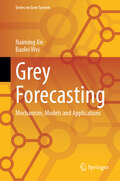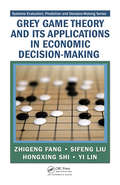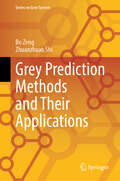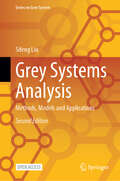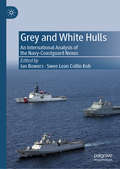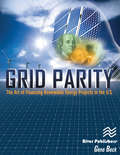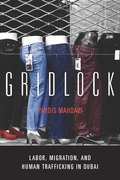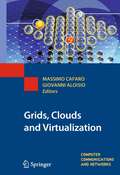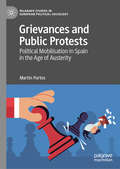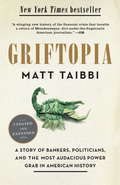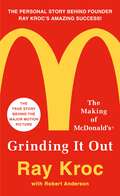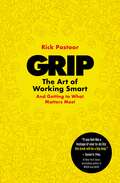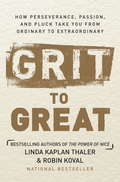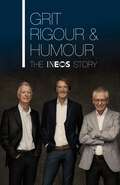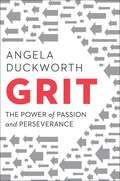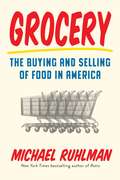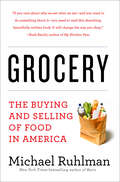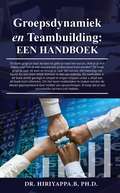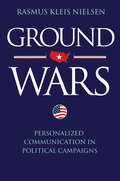- Table View
- List View
Grey Forecasting: Mechanism, Models and Applications (Series on Grey System)
by Naiming Xie Baolei WeiThis book aims to present an overview of grey system models for time series modelling and forecasting. It is about modelling and forecasting time series with ordinary differential equations, especially when the available samples are extremely limited. Grey system models (GSM) develop sequence operators to nonparametrically identify the underlying dynamics from the limited observations. This book concerns about two important modelling themes, small sample and poor information. The former focuses on the mechanism and methodology of GSMs for small-sample real-number time series, and the latter on the uncertainty quantification of grey number together with its small-sample modelling principles. In this book, a broad entry point to applied data science for students majoring in economic, management science, and engineering is applied, covering a wide range of topics from basic introductory material up to research-level techniques.
Grey Game Theory and Its Applications in Economic Decision-Making (Systems Evaluation, Prediction, and Decision-Making)
by Yi Lin Sifeng Liu Zhigeng Fang Hongxing ShiTo make the best decisions, you need the best information. However, because most issues in game theory are grey, nearly all recent research has been carried out using a simplified method that considers grey systems as white ones. This often results in a forecasting function that is far from satisfactory when applied to many real situations. Grey Ga
Grey Prediction Methods and Their Applications (Series on Grey System)
by Bo Zeng Zhuanzhuan ShiThis book introduces the grey prediction model methodology and its applications as a professional book. It involves the key concepts, data characteristics of modelling objects and the latest research achievements in grey system. The grey prediction models for homogeneous and non-homogeneous exponential sequences, saturated S-shaped sequences and special sequences have been introduced. This book combines the classical models and the latest models, case studies and model applications, modelling methods, and MATLAB programs in grey system. It is a guidebook for both new learners and professionals of grey prediction models.
Grey Systems Analysis: Methods, Models and Applications (Series on Grey System)
by Sifeng LiuThis open access book is the 2nd edition involving the update on data, methods and models of Grey Systems. It covers up-to-date theoretical and applied advances in grey systems from across the world, and vividly presents the reader with the overall picture of this new theory and its frontier research. Many of the concepts, models and methods in the book are original by the author, including kernel, degree of greyness of grey number, simplified form of grey number, general grey number and the operation system; the axiomatic system of buffer operators and a series of weakening and strengthening buffer operators; a series of grey relational analysis models, including grey absolute, relative, synthetic, similarity, closeness, negative, three dimension, and grey relational analysis model for cross-sequences, etc.; grey fixed weight clustering model, grey evaluation models based on center-point and end-point mixed possibility functions; original difference grey model (ODGM), even difference grey model (EDGM), discrete grey model (DGM), fractional grey models, self-memory grey models; multi-attribute weighted intelligent grey target decision models, kernel weight vector group and the weighted comprehensive clustering coefficient vector, and spectrum analysis of sequence operators, etc. The revision includes: (1) Added new achievements made in recent years, such as the moving average denoise operator, a series of negative grey relational models, grey relational model for cross-sequences, standard uncertainty numbers and their operations, adaptive Grey Prediction Models and so on; (2) Important data related to the development of grey system theory has been updated; (3) Research reviews have been added to each chapter, and a large number of references have been added; (4)Updated application examples of commonly used models and methods. This book will be appropriate as a reference and/or textbook for courses of grey system theory for graduate students or high level undergraduate students, majoring in various fields of natural sciences, social sciences and engineering technology. It can also be utilized by researchers and technicians in research institutions, business entities, and government agencies.
Grey and White Hulls: An International Analysis of the Navy-Coastguard Nexus
by Ian Bowers Swee Lean Collin KohThis book undertakes an in-depth examination of the diversity in international approaches to the navy-coastguard nexus. It considers the evolving global maritime security landscape and the emergence and proliferation of maritime law enforcement agencies—collectively referred to here as “coastguards”—performing peacetime constabulary duties alongside navies. Through a cross-regional study of various countries worldwide, including those in Asia and Europe, this book reveals that there is no one optimal, “one size fits all” organizational structure. Instead, there is a wide array of drivers that influence a nation-state’s maritime security architecture and its organizational approach to managing security at sea, or broadly speaking, securing its national maritime interests.
Grid Parity and Carbon Footprint: An Analysis For Residential Solar Energy In The Mediterranean Area (SpringerBriefs in Energy)
by Ángel Arcos-Vargas Laureleen RiviereThis book analyses the economic and environmental aspects of installing photovoltaic facilities for residential electricity users and determines whether the installation of photovoltaic units “behind the meter” makes sense, and if so, the best economic size to install. It explores the use of photovoltaic capacity to meet electricity requirements by generating enough for immediate use without feeding surplus electricity into the grid and without using storage. The authors illustrate this approach by examining various power photovoltaic capacities in locations such as Marseille, Madrid and Seville, which use hourly demand data provided by smart meters. They also show the possibility of developing energy self-consumption compatible with the operation of the network, making use of information from smart meters. Discussing how photovoltaic facilities are profitable from both an economic and an environmental point of view, this book is a valuable resource for researchers and private investors. It is also of interest to practitioners and academics, as the results presented are of importance for the near future.
Grid Parity: The Art of Financing Renewable Energy Projects in the U.S.
by CLP Beck CEMGrid Parity provides an in-depth examination of the knowledge, insights, and techniques that are essential to success in financing renewable energy projects. An energy project finance expert with 35 years of experience in capital asset financing, the author provides a comprehensive overview of how to finance renewable energy projects in America today. He explores all components of "the deal" including tax, accounting, legal, regulatory, documentation, asset management and legislative drivers to this dynamic growth sector. Filled with case studies, the book provides a thorough examination of what it takes to compete in the green-energy marketplace.
Gridlock
by Pardis MahdaviMahdavi (anthropology, Pomona College) qualitatively explores how Euro-American discourses and policies (forged primarily in Washington D. C. ) about human trafficking and migration affect the lived experiences of migration, forced labor, and trafficking in the United Arab Emirates, arguing that many of the policies ostensibly designed to reduce abuse and rights violations have had precisely the opposite effect. Instead of approaching trafficking as a criminal matter, she suggests, one needs to see it as a matter of migration and labor gone awry and thus as a human rights matter. Annotation ©2011 Book News, Inc. , Portland, OR (booknews. com)
Grids, Clouds and Virtualization
by Giovanni Aloisio Massimo CafaroResearch into grid computing has been driven by the need to solve large-scale, increasingly complex problems for scientific applications. Yet the applications of grid computing for business and casual users did not begin to emerge until the development of the concept of cloud computing, fueled by advances in virtualization techniques, coupled with the increased availability of ever-greater Internet bandwidth. The appeal of this new paradigm is mainly based on its simplicity, and the affordable price for seamless access to both computational and storage resources. This timely text/reference introduces the fundamental principles and techniques underlying grids, clouds and virtualization technologies, as well as reviewing the latest research and expected future developments in the field. Readers are guided through the key topics by internationally recognized experts, enabling them to develop their understanding of an area likely to play an ever more significant role in coming years. Topics and features: presents contributions from an international selection of experts in the field; provides a thorough introduction and overview of existing technologies in grids, clouds and virtualization, including a brief history of the field; examines the basic requirements for performance isolation of virtual machines on multi-core servers, analyzing a selection of system virtualization technologies; examines both business and scientific applications of grids and clouds, including their use in the life sciences and for high-performance computing; explores cloud building technologies, architectures for enhancing grid infrastructures with cloud computing, and cloud performance; discusses energy aware grids and clouds, workflows on grids and clouds, and cloud and grid programming models. This useful text will enable interested readers to familiarize themselves with the key topics of grids, clouds and virtualization, and to contribute to new advances in the field. Researchers, undergraduate and graduate students, system designers and programmers, and IT policy makers will all benefit from the material covered.
Grievances and Public Protests: Political Mobilisation in Spain in the Age of Austerity (Palgrave Studies in European Political Sociology)
by Martín PortosThis book sheds light on the role that grievances play for mobilisation dynamics in a context of material deprivation. Why do people protest? To what extent do grievances account for the varying size of protest events over time? Covering different levels of analysis, the author argues that effects of socioeconomic aspects (both objective-material deprivation and subjective-attitudinal grievances) are mediated by political attitudes, especially political dissatisfaction. He develops a framework to account for the dynamics, trajectory and timing of the cycle of contention that unfolded in Spain in the shadow of the Great Recession, contributing not only to the field of social movement studies but to our broader understanding of European politics, political sociology, political economy and economic sociology.
Griftopia: Bubble Machines, Vampire Squids, and the Long Con That Is Breaking America
by Matt TaibbiA brilliantly illuminating and darkly comic tale of the ongoing financial and political crisis in America The financial crisis that exploded in 2008 isn't past but prologue. The grifter class--made up of the largest players in the financial industry and the politicians who do their bidding--has been growing in power, and the crisis was only one terrifying manifestation of how they've hijacked America's political and economic life.Matt Taibbi has combined deep sources, trailblazing reportage, and provocative analysis to create the most lucid, emotionally galvanizing account yet written of this ongoing American crisis. He offers fresh reporting on the backroom deals of the bailout; tells the story of Goldman Sachs, the "vampire squid wrapped around the face of humanity"; and uncovers the hidden commodities bubble that transferred billions of dollars to Wall Street while creating food shortages around the world.This is essential reading for anyone who wants to understand the labyrinthine inner workings of this country, and the profound consequences for us all.
Grinding It Out: The Making of McDonald's
by Ray Kroc"He either enchants or antagonizes everyone he meets. But even his enemies agree there are three things Ray Kroc does damned well: sell hamburgers, make money, and tell stories." --from Grinding It OutFew entrepreneurs can claim to have radically changed the way we live, and Ray Kroc is one of them. His revolutions in food-service automation, franchising, shared national training, and advertising have earned him a place beside the men and women who have founded not only businesses, but entire empires. But even more interesting than Ray Kroc the business man is Ray Kroc the man. Not your typical self-made tycoon, Kroc was fifty-two years old when he opened his first franchise. In Grinding It Out, you'll meet the man behind McDonald's, one of the largest fast-food corporations in the world with over 32,000 stores around the globe.Irrepressible enthusiast, intuitive people person, and born storyteller, Kroc will fascinate and inspire you on every page.
Gringo Gulch: Sex, Tourism, and Social Mobility in Costa Rica
by Megan Rivers-MooreThe story of sex tourism in the Gringo Gulch neighborhood of San José, Costa Rica could be easily cast as the exploitation of poor local women by privileged North American men—men who are in a position to take advantage of the vast geopolitical inequalities that make Latin American women into suppliers of low-cost sexual labor. But in Gringo Gulch, Megan Rivers-Moore tells a more nuanced story, demonstrating that all the actors intimately entangled in the sex tourism industry—sex workers, sex tourists, and the state—use it as a strategy for getting ahead. Rivers-Moore situates her ethnography at the intersections of gender, race, class, and national dimensions in the sex industry. Instead of casting sex workers as hapless victims and sex tourists as neoimperialist racists, she reveals each group as involved in a complicated process of class mobility that must be situated within the sale and purchase of leisure and sex. These interactions operate within an almost entirely unregulated but highly competitive market beyond the reach of the state—bringing a distinctly neoliberal cast to the market. Throughout the book, Rivers-Moore introduces us to remarkable characters—Susan, a mother of two who doesn’t regret her career of sex work; Barry, a teacher and father of two from Virginia who travels to Costa Rica to escape his loveless, sexless marriage; Nancy, a legal assistant in the Department of Labor who is shocked to find out that prostitution is legal and still unregulated. Gringo Gulch is a fascinating and groundbreaking look at sex tourism, Latin America, and the neoliberal state.
Gringos in Paradise
by Barry GolsonA Year in ProvencemeetsMr. Blandings Builds His Dream Housein this lively and entertaining account of a couple's year building their dream house in Mexico. In 2004, Barry Golson wrote an award-winning article forAARPmagazine about Mexican hot spots for retirees longing for a lifestyle they couldn't afford in the United States. A year later, he and his wife Thia were taking part in the growing trend of retiring abroad. They sold their Manhattan apartment, packed up their SUV, and moved to one of those idyllic hot spots, the surfing and fishing village of Sayulita on Mexico's Pacific coast. With humor and charm, Golson details the year he and his wife spent settling into their new life and planning and building their dream home. Sayulita -- population 1,500, not including stray dogs or pelicans -- is a never-dull mixture of traditional Mexican customs and new, gringo-influenced change. Before long, the Golsons had been absorbed into the rhythms and routines of village life: they adopted a pair of iguanas named Iggy Pop and Iggy Mom, got sick and got cured by a doctor who charged them sixteen dollars a visit, made lasting friends with Mexicans and fellow expatriates, and discovered the skill and artistry of local craftsmen. But their daily lives were mostly dedicated to the difficult yet satisfying process of building their house. It took them almost six months to begin building -- nothing is simple (or speedy) in Mexico -- and incredibly, they completed construction in another six. They engaged a Mexican architect, builder, and landscape designer who not only built their home but also changed their lives; encountered uproariously odd bureaucracy; and ultimately experienced a lifetime's worth of education about the challenges and advantages of living in Mexico. The Golsons lived (and are still living) the dream of many -- not only of going off to a tropical paradise but also of building something beautiful, becoming a part of a new world, making lasting friends, and transforming their lives. As much about family and friendship as about house-building,Gringos in Paradiseis an immensely readable and illuminating book about finding a personal paradise and making it a home.
Grip: The Art of Working Smart (And Getting to What Matters Most)
by Rick Pastoor&“If you feel like a hostage of your to-do list and struggle to find time for what matters most, this book will be a huge help.&” —Daniel H. Pink, #1 New York Times bestselling author of When and DriveWe&’re all familiar with the signs that things are getting out of hand. The week has barely started and already you&’re playing catch-up. At the end of another busy day, your to-do list is longer than it was that morning, your inbox overflowing with other people&’s asks.At times like those, no matter how hard we work, it can feel like we&’re spinning our wheels.Enter GRIP: The Art of Working Smart, by Dutch entrepreneur and bestselling author Rick Pastoor. GRIP is a fresh and forgiving guide that helps you get things done and free up time for what&’s important to you.In the space of one year, Rick went from being a 25-year-old engineering hire to leading a team of 30 at Blendle, the New York Times-backed journalism startup. It was clear he needed a new way of working. And fast.So, Rick started experimenting. He&’d keep what worked, ditch what didn&’t, and share with coworkers what he learned along the way. The result is GRIP: a flexible collection of tools and insights that helped the team do their best work. Now it can do the same for you.An overnight sensation in Holland, this bestseller has helped thousands find clarity amid the chaos of our demanding times. Now available in English, for everyone who&’s looking to reclaim their sanity and add direction to even the most hectic days and weeks.Rick's friendly, no-nonsense approach makes it easy to dive in. The book&’s pick-and-choose structure, complete with cheat sheets for each section, means you can start applying what you need straightaway.GRIP walks you through:Unlocking the power of everyday tools you&’re already using like a calendar, to-do list, and emailLowering the volume on distractions to find your focusAnd freeing up room to think big and growSo you can get started on making your dreams a reality.
Grit to Great: How Perseverance, Passion, and Pluck Take You from Ordinary to Extraordinary
by Linda Kaplan Thaler Robin KovalIn Grit to Great, Linda Kaplan Thaler and Robin Koval tackle a topic that is close to their hearts, one that they feel is the real secret to their own success in their careers--and in the careers of so many people they know and have met. And that is the incredible power of grit, perseverance, perspiration, determination, and sheer stick-to-it-tiveness. We are all dazzled by the notion that there are some people who get ahead, who reach the corner office because they are simply gifted, or well-connected, or both. But research shows that we far overvalue talent and intellectual ability in our culture. The fact is, so many people get ahead--even the gifted ones--because they worked incredibly hard, put in the thousands of hours of practice and extra sweat equity, and made their own luck. And Linda and Robin should know--they are two girls from the Bronx who had no special advantages or privileges and rose up through their own hard work and relentless drive to succeed to the top of their highly competitive profession. In a book illustrated with a cornucopia of stories and the latest research on success, the authors reveal the strategies that helped them, and countless others, succeed at the highest levels in their careers and professions, and in their personal lives. They talk about the guts--the courage--necessary to take on tough challenges and not give up at the first sign of difficulty. They discuss the essential quality of resiliency. Everyone suffers setbacks in their careers and in life. The key, however, is to pick yourself up and bounce back. Drawing on the latest research in positive psychology, they discuss why optimists do better in school, work, and on the playing field--and how to reset that optimistic set point. They talk about industriousness, the notion that Malcolm Gladwell popularized with the 10,000-hour rule in his book Outliers. Creativity theorist Mihaly Csikszentmihalyi believes it takes a minimum of 10 years for one's true creative potential to be realized. And the authors explore the concept of tenacity--the quality that allows us to remain focused and avoid distraction in order to get the job done--an increasingly difficult task in today's fragmented, cluttered, high-tech, connected world.Written in the same short, concise format as The Power of Nice and leavened with the natural humor that characterizes Linda's and Robin's lives--and books--Grit to Great is destined to be the book everyone in business needs.
Grit, Rigour & Humour: The INEOS Story
by Patrick Barclay Andrew Likierman Sebastian Coe Sir Jim Ratcliffe Dominic O'Connell Quentin Willson Sean Keach Steph McGovern'Manual for success' The AthleticWith an opening chapter by Sir Jim RatcliffeTo mark the 25th Anniversary of the founding of INEOS in 1998, seven leading specialist authors explore the main strands of INEOS's business, including its core chemical business to its ventures into sport, automotive, consumer goods, sustainability, next generation and philanthropy.* Dominic O'Connell on INEOS' core petrochemicals and energy business* Patrick Barclay on INEOS's involvement in sport from the America's Cup to cycling, athletics to Formula 1 and football* Quentin Willson on the building of the Grenadier from scratch in response to the demise of the Land Rover Defender* Steph McGovern on INEOS' move into the consumer goods sector with brands such as Belstaff and INEOS Hygienics, so vital during the pandemic* Sean Keach on INEOS' journey to Net Zero and sustainable investment* Lord Sebastian Coe on the vital importance of exercise for the next generation, with a particular focus on INEOS's worldwide children's exercise initiative, 'The Daily Mile', and the 'Forgotten 40', the 40% of the UK's young who are affected by a lack of basic resources to remain fit and healthy* Sir Andrew Likierman on INEOS' philanthropic projects and investmentsGrit, Rigour & Humour offers an extraordinary and balanced insight into the rise of one of the world's most successful companies, which produces the essential building blocks used in most of the products you use daily from medical products and packaging to electronics and transport, and has expanded rapidly over the past decade into one with interests in many diverse walks of life.
Grit: The Power of Passion and Perseverance
by Angela Duckworth<P>In this instant New York Times bestseller, pioneering psychologist Angela Duckworth shows anyone striving to succeed--be it parents, students, educators, athletes, or business people--that the secret to outstanding achievement is not talent but a special blend of passion and persistence she calls "grit." <P>Drawing on her own powerful story as the daughter of a scientist who frequently noted her lack of "genius," Duckworth, now a celebrated researcher and professor, describes her early eye-opening stints in teaching, business consulting, and neuroscience, which led to the hypothesis that what really drives success is not "genius" but a unique combination of passion and long-term perseverance. In Grit, she takes readers into the field to visit cadets struggling through their first days at West Point, teachers working in some of the toughest schools, and young finalists in the National Spelling Bee. <P>She also mines fascinating insights from history and shows what can be gleaned from modern experiments in peak performance. Finally, she shares what she's learned from interviewing dozens of high achievers--from JP Morgan CEO Jamie Dimon to New Yorker cartoon editor Bob Mankoff to Seattle Seahawks Coach Pete Carroll. Among Grit's most valuable insights: *Why any effort you make ultimately counts twice toward your goal *How grit can be learned, regardless of I.Q. or circumstances *How lifelong interest is triggered *How much of optimal practice is suffering and how much ecstasy *Which is better for your child--a warm embrace or high standards *The magic of the Hard Thing Rule <P>Winningly personal, insightful, and even life-changing, Grit is a book about what goes through your head when you fall down, and how that--not talent or luck--makes all the difference. <P><b>A New York Times Bestseller</b>
Grocery Story: The Promise Of Food Co-ops In The Age Of Grocery Giants
by Jon SteinmanHungry for change? Put the power of food co-ops on your plate and grow your local food economy. <p><p> Food has become ground-zero in our efforts to increase awareness of how our choices impact the world. Yet while we have begun to transform our communities and dinner plates, the most authoritative strand of the food web has received surprisingly little attention: the grocery store—the epicenter of our food-gathering ritual. <p> Through penetrating analysis and inspiring stories and examples of American and Canadian food co-ops, Grocery Story makes a compelling case for the transformation of the grocery store aisles as the emerging frontier in the local and good food movements. Author Jon Steinman: <p> Deconstructs the food retail sector and the shadows cast by corporate giants Makes the case for food co-ops as an alternative Shows how co-ops spur the creation of local food-based economies and enhance low-income food access. <p> Grocery Story is for everyone who eats. Whether you strive to eat more local and sustainable food, or are in support of community economic development, Grocery Story will leave you hungry to join the food co-op movement in your own community.
Grocery Story: The Promise of Food Co-ops in the Age of Grocery Giants
by Jon SteinmanHungry for change? Put the power of food co-ops on your plate and grow your local food economy. Food has become ground-zero in our efforts to increase awareness of how our choices impact the world. Yet while we have begun to transform our communities and dinner plates, the most authoritative strand of the food web has received surprisingly little attention: the grocery store—the epicenter of our food-gathering ritual.Through penetrating analysis and inspiring stories and examples of American and Canadian food co-ops, Grocery Story makes a compelling case for the transformation of the grocery store aisles as the emerging frontier in the local and good food movements. Author Jon Steinman:Deconstructs the food retail sector and the shadows cast by corporate giantsMakes the case for food co-ops as an alternativeShows how co-ops spur the creation of local food-based economies and enhance low-income food access.Grocery Story is for everyone who eats. Whether you strive to eat more local and sustainable food, or are in support of community economic development, Grocery Story will leave you hungry to join the food co-op movement in your own community.
Grocery: The Buying and Selling of Food in America
by Michael RuhlmanIn a culture obsessed with food—how it looks, what it tastes like, where it comes from, what is good for us—there are often more questions than answers. Ruhlman proposes that the best practices for consuming wisely could be hiding in plain sight—in the aisles of your local supermarket. Using the human story of the family-run Midwestern chain Heinen's as an anchor to this journalistic narrative, he dives into the mysterious world of supermarkets and the ways in which we produce, consume, and distribute food. Grocery examines how rapidly supermarkets—and our food and culture—have changed since the days of your friendly neighborhood grocer. But rather than waxing nostalgic for the age of mom-and-pop shops, Ruhlman seeks to understand how our food needs have shifted since the mid-twentieth century, and how these needs mirror our cultural ones. A mix of reportage and rant, personal history and social commentary, Grocery is a landmark book from one of our most insightful food writers.
Grocery: The Buying and Selling of Food in America
by Michael RuhlmanThe New York Times–bestselling author “digs deep into the world of how we shop and how we eat. It’s a marvelous, smart, revealing work” (Susan Orlean, #1 bestselling author).In a culture obsessed with food—how it looks, what it tastes like, where it comes from, what is good for us—there are often more questions than answers. Ruhlman proposes that the best practices for consuming wisely could be hiding in plain sight—in the aisles of your local supermarket. Using the human story of the family-run Midwestern chain Heinen’s as an anchor to this journalistic narrative, he dives into the mysterious world of supermarkets and the ways in which we produce, consume, and distribute food. Grocery examines how rapidly supermarkets—and our food and culture—have changed since the days of your friendly neighborhood grocer. But rather than waxing nostalgic for the age of mom-and-pop shops, Ruhlman seeks to understand how our food needs have shifted since the mid-twentieth century, and how these needs mirror our cultural ones.A mix of reportage and rant, personal history and social commentary, Grocery is a landmark book from one of our most insightful food writers.“Anyone who has ever walked into a grocery store or who has ever cooked food from a grocery store or who has ever eaten food from a grocery store must read Grocery. It is food journalism at its best and I’m so freakin’ jealous I didn’t write it.” —Alton Brown, television personality“If you care about why we eat what we eat—and you want to do something about it—you need to read this absorbing, beautifully written book.” —Ruth Reichl, New York Times–bestselling author
Groepsdynamiek en Teambuilding: Een handboek
by Hiriyappa BDit boek grijpt je naar de keel en gidst je naar het succes. Heb je je ooit afgevraagd hoe je een succesvolle professional kunt worden? Dit boek grijpt je naar de keel en brengt je naar het succes. Het bevestigt het beeld dat een team altijd slimmer is dan een individu. De methodiek in dit boek wordt gevolgd in simpel te volgen stappen zodat u altijd aan dit boek kunt refereren. Om het lezen makkelijker te maken worden de ideeen gepresenteerd door middel van opsommingen. Ik hoop dat je een succesvolle carriere zult hebben.
Groom Energy Solutions: Selling Efficiency
by Michael W. Toffel Stephanie Van Sice Kira FabrizioGroom Energy Solutions helps organizations reduce their energy use and costs through the implementation of energy efficiency measures, which create long-term financial and environmental benefits. With early success serving customers in the cold storage and industrial manufacturing sectors, the seven-year-old company must now decide whether to continue expanding within these segments or transition into commercial retail and office buildings, which offer growth potential and unique challenges. Groom Energy must also decide which geographic regions provide the best opportunity. This case study provides background on the history of the energy efficiency industry, the energy efficiency paradox, and the benefits and challenges of a business focused on implementing efficiency measures. The case is particularly relevant to courses focused on energy management, environmental sustainability, and entrepreneurship within the energy and sustainability areas.
Ground Wars: Personalized Communication in Political Campaigns
by Rasmus Kleis NielsenPolitical campaigns today are won or lost in the so-called ground war--the strategic deployment of teams of staffers, volunteers, and paid part-timers who work the phones and canvass block by block, house by house, voter by voter. Ground Wars provides an in-depth ethnographic portrait of two such campaigns, New Jersey Democrat Linda Stender's and that of Democratic Congressman Jim Himes of Connecticut, who both ran for Congress in 2008. Rasmus Kleis Nielsen examines how American political operatives use "personalized political communication" to engage with the electorate, and weighs the implications of ground war tactics for how we understand political campaigns and what it means to participate in them. He shows how ground wars are waged using resources well beyond those of a given candidate and their staff. These include allied interest groups and civic associations, party-provided technical infrastructures that utilize large databases with detailed individual-level information for targeting voters, and armies of dedicated volunteers and paid part-timers. Nielsen challenges the notion that political communication in America must be tightly scripted, controlled, and conducted by a select coterie of professionals. Yet he also quashes the romantic idea that canvassing is a purer form of grassroots politics. In today's political ground wars, Nielsen demonstrates, even the most ordinary-seeming volunteer knocking at your door is backed up by high-tech targeting technologies and party expertise. Ground Wars reveals how personalized political communication is profoundly influencing electoral outcomes and transforming American democracy.
